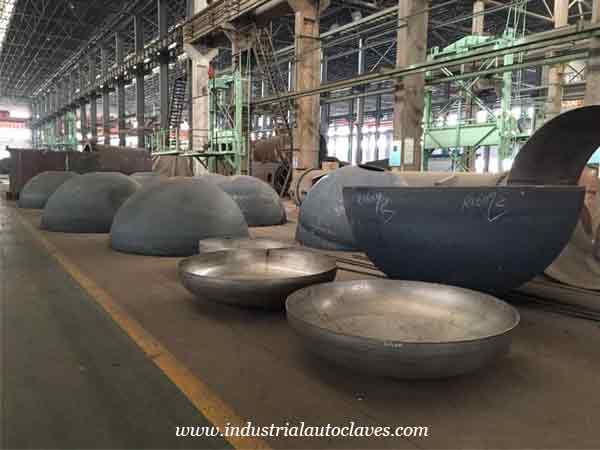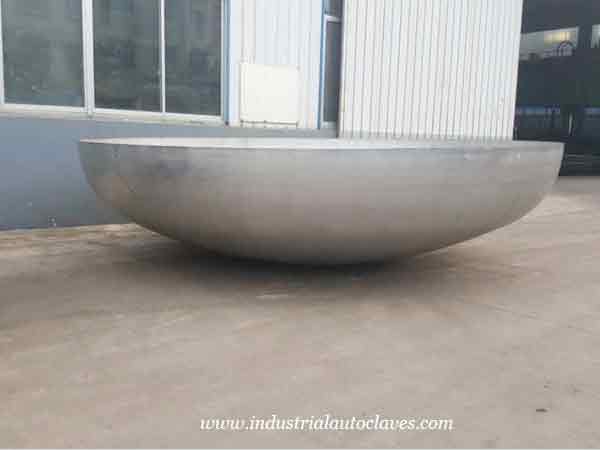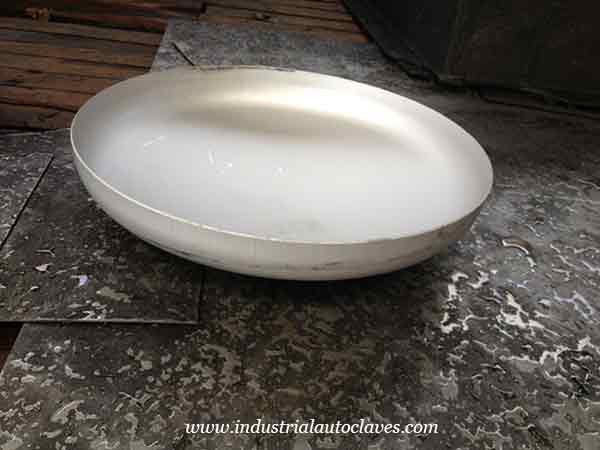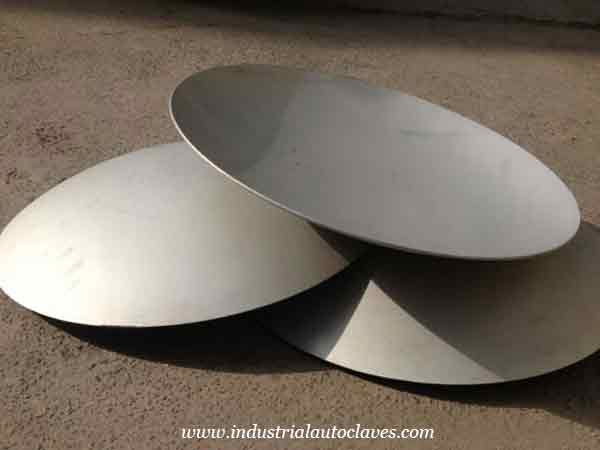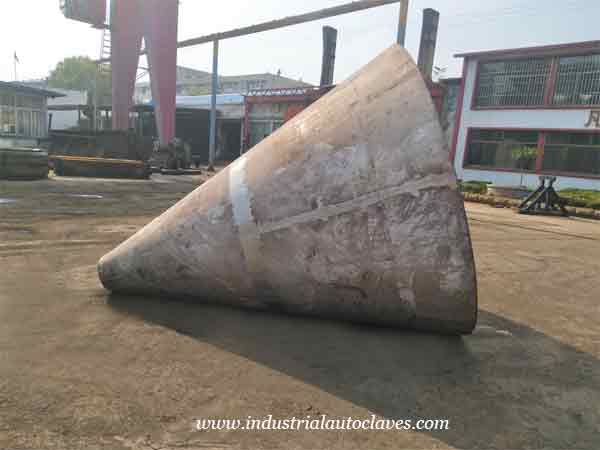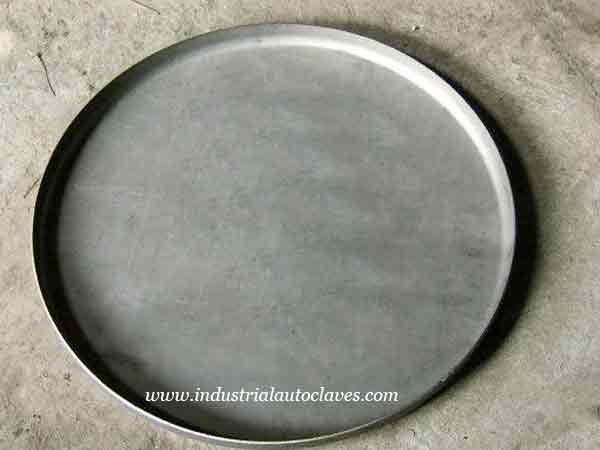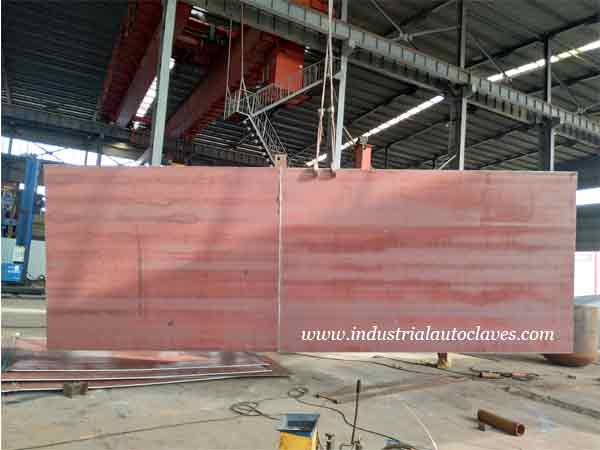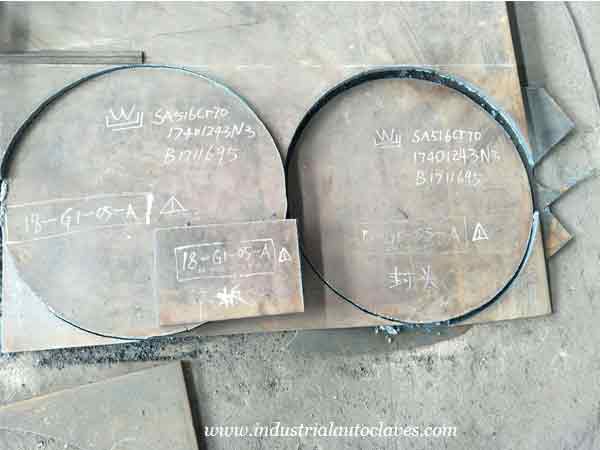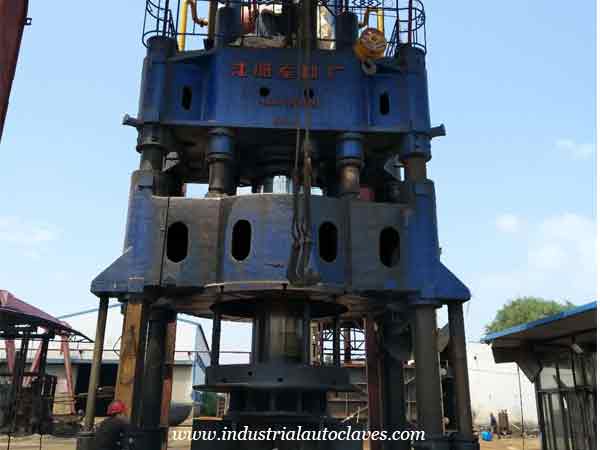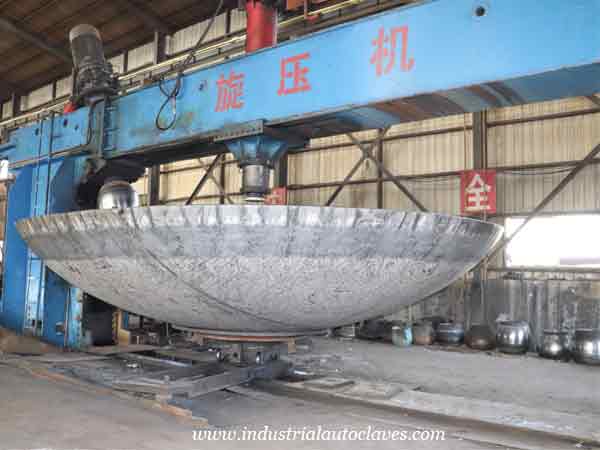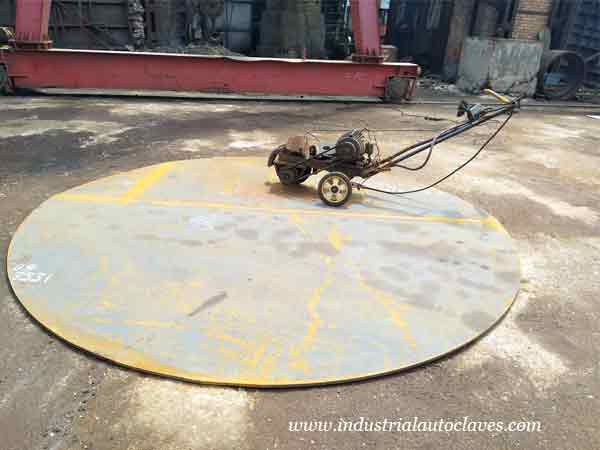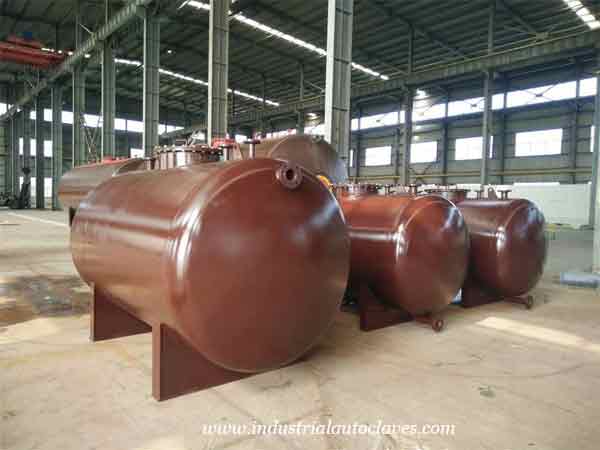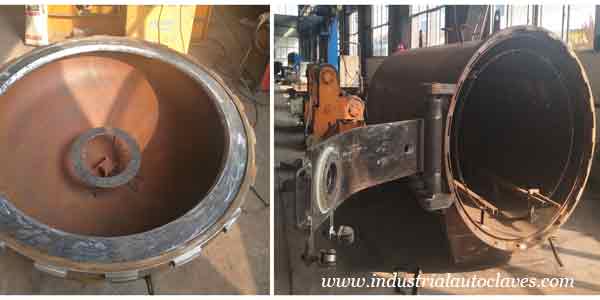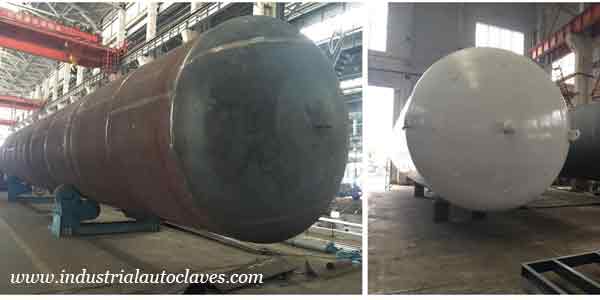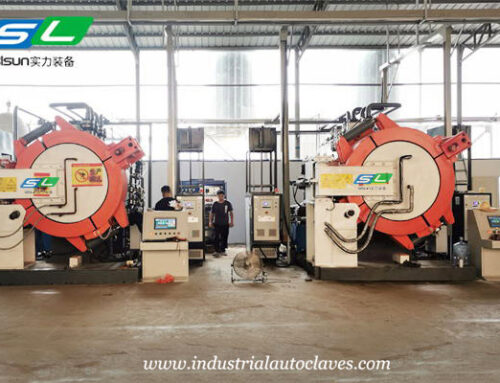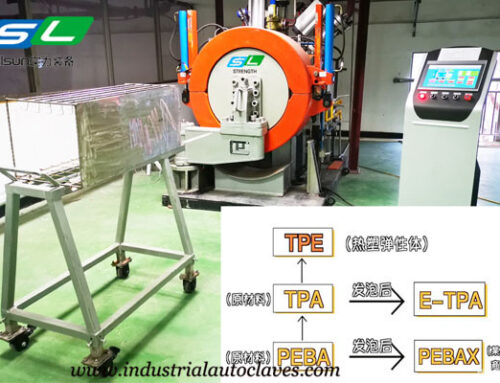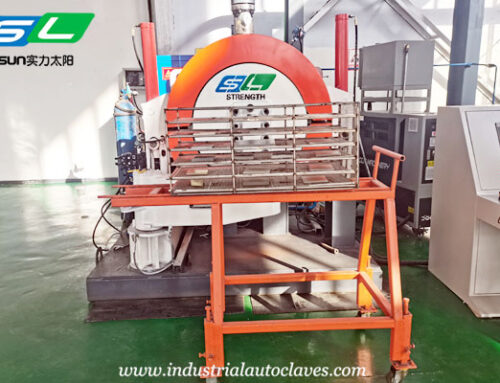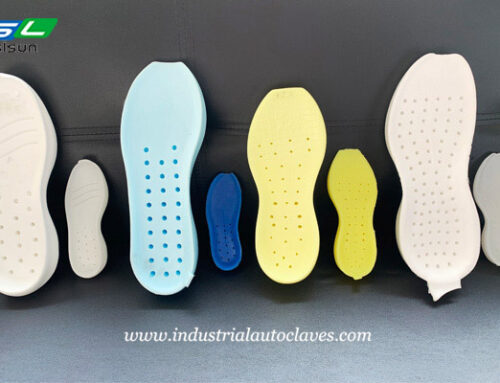Dished end, also called dished head or tank head, is an important pressure element for pressure vessels and boilers. The dished end is usually used at both ends of the pressure vessel and welded with the cylinder. According to the different geometric shapes, it can be divided into elliptical tank head, torispherical end, hemispherical dish end, spherical end, conical end, flat end, etc. High pressure vessels and boiler heads are mostly hemispherical, and elliptical are used for medium pressure and only a small number of low pressure vessels use torispherical.
Dished End Type and Form
- Elliptical tank head is composed of half an ellipsoidal shell and a straight edge of a cylinder. The most common application is the form of the ratio of the major axis to the minor axis, which is called the standard ellipsoidal head.
1.1 Dished End Membrane Stress
The longitudinal stress at the center of the dished head is the maximum, which is the tensile film stress. It gradually decreases along the warp to the bottom edge of the head, and when it reaches the bottom, it tends to be the minimum and equal to the axial stress of the butting cylinder.
The circumferential stress on the dished head shows the maximum tensile stress in the center of the head, equal to the meridional pressure, it gradually decreases along the meridian to the base of the head, from tensile stress to compressive stress, and the compressive stress at the bottom of the head reaches a maximum.
1.2 Dished End Edge stress
The curved surface of the ellipsoidal head is connected with the cylinder of straight section, under the action of internal pressure, the cylinder expands radially, and the ellipsoidal shell edge contracts radially.
The head generates additional bending stress and film stress under the action of the boundary force. These stresses are superimposed with the stress of the film under internal pressure to form the final stress state of the head.
2. Torispherical end is composed of a spherical cap with a larger radius from the center, a ring shell with a smaller radius around it, and a straight section of a cylinder.
- 1 Dished End Membrane StressThe radial stress is evenly distributed on the spherical surface of the head, which is the tensile film stress. The stress in the transition zone gradually decreases, and the stress is reduced to half when it reaches the bottom edge of the head and equal to the axial stress of the docking cylinder.Torispherical end is composed of a spherical cap, a ring shell (transition zone) and a cylindrical shell (straight side), and the free deformation of the three parts is different. These boundary forces make the deformation between the above-mentioned shells continuous, and also change the stress state of the shell. The magnitude of the boundary force has a great influence on the stress of the shell, and the magnitude of the boundary force on the two boundaries of the head is related to the free deformation of the elements on both sides of the boundary.
- Hemispherical dish end are semi or nearly half spherical shell, smaller diameter hemispherical heads can be integrally formed. It is difficult to press the larger diameter as a whole.Therefore, it is necessary to use several trapezoidal spheres of the same size and a circular ball (crown) at the top center to weld. Hemispherical heads and other types of heads are required to have the smallest thickness required under the same conditions of diameter and pressure, the smallest surface area when the heads have the same volume, and the smallest amount of materials and uniform force. However, due to manufacturing difficulties, in addition to pressure vessels with higher pressure and larger diameter, other vessels are generally used less frequently.
- Spherical end is a part of the spherical surface directly connected with the cylinder, due to the simple structure, easy to manufacture, often used as a vessel in the two independent pressure chamber of the middle head can also be used as end caps. Because there is no corner transition between the spherical surface and the cylinder, there is considerable discontinuous stress on the seal head and the cylinder near the joint. The stress distribution is not very reasonable. Therefore, in the low-pressure vessel equipment, the spherical head can be used. The biggest advantage of the spherical head is that any diameter can be customized. The boundary forces and bending moments mainly affect the stress near the joint edge, so the stress at the near-central part of the spherical cap is still dominated by the stress of the film. The stress on the cylinder farther away from the spherical cap is also dominated by the stress of the film. The connection between the spherical cap and the cylinder is affected by the boundary force, etc., and additional radial and circumferential bending stress and local film stress are induced on the basis of the original film stress.
5. Conical end, the main part of the conical head cone undergoes internal pressure and the maximum film stress occurs at the big end. Due to the geometric discontinuity and the sudden change in radius of curvature, the connection between the cone and the cylindrical part will generate a large transverse thrust at this point, causing a large edge stress and bending, and therefore it needs to be strengthened. For the big end, the axial bending stress is the main control factor, and it belongs to the secondary stress, so the stress intensity is controlled. For the small end, the stress state of the joint between the small end and the cylinder is mainly the average circumferential tensile stress and average. Radial compressive stress is a local film stress, so the stress intensity can be controlled, but because the local film stress here may exceed the distribution of the edge effect, for the sake of safety, the stress intensity is controlled within. For large end, the thickness of the reinforced section shall not be less than the thickness of the connected conical shell in any case, the length of the reinforced section shall not be less than the length of the reinforced section of the cylinder shall not be less than.
6.Flat end, usually a round flat plate, can be connected to the cylinder by welding, or it can be connected to the flange by a bolt washer. The stress generated by the flat head under the action of pressure and the surrounding radial bending moment is the bending stress, which is divided into two directions, radial and circumferential. For this reason, usually there is only strength problem and there is no stability problem.
Flat heads under the uniform distribution of the surrounding bending moment, the two directions of the stress is evenly distributed, and the two are equal, said the pure bending state.
Dished End Production Process
Seamless: raw material into the factory –material reinspection — head blanking, material marking — select the right mold, stamping through external force — head shape verification (straight edge height, surface depth, dimensions, roundness, thickness, etc.) — after forming to cut the groove — groove for grinding processing — in order to make the surface smooth, stainless steel needs pickling and passivation, carbon steel needs sand blasting — final inspection, labeling, storage.
Welding: raw material into the factory — material re inspection — head blanking, material marking — milling machine for groove making — welding into a whole circle — grinding welds should be flush with the parent material and not lower than the parent material — Non-destructive testing — selecting the right mold, stamping by external force — head shape verification (straight edge height, surface depth, dimensions, roundness, thickness, etc.) — after forming to cut the groove-groove for grinding processing — in order to make the surface smooth, stainless steel needs pickling and passivization, carbon steel needs sand blasting — final inspection, labeling, storage.
Dished End Pressing Methods
- Stamping of Dished End
- Stamping Operation
Stamping is an important operation for forming small and medium sized heads, it’s also the process of cracking heads and reducing the number of process steps.
- Composition of Stamping Machine
- Main Cylinder,it is mainly used to connect the die and is a necessary condition for forming the head.
- Side Cylinder, it is used to press the upper die ring, fix the head discs in the upper and lower die rings, which is an important part to prevent the head from wrinkling and bulging in the pressing process.
- Relief Valve, it is used to control the overall pressure of the press and prevent the wafer from tearing during the pressing process.
- Stamping Valve, when the pressure is too high, the stamping valve relieves the pressure and achieves pressure equalization.
In addition, the manifolds, motor, fuel tank, operating floor, and base are all components of the press.
- Stamping Operation Steps of Dished End
- First, after receiving the flow card of the blanking process, find the corresponding circle.
- According to the technological requirements of the process flow card, replace the corresponding set of molds, and determine the selected mold size and the size of the circle to be pressed.
- The circle is clamped in the upper and lower mold rings, and the center point of the die is determined in a straight line with the center point of the circle.
- Operating the relative movement of the die ring and the die head to test pressure, determine the pressure according to the rebound strength of the control rod, and adjust the pressure.
- After the pressure test is completed, the circle is pressed and punched.
- Stamping Operation Standard of Dished End
- Compare the task list to confirm whether the physical object and the process card are the same, and confirm the number, material, specification, and batch number of the workpiece to be processed according to the process card.
- According to the correct selection of mold process card, check the surface of the mold, found that the wound and serious strain must be polished, while the surface of the mold must be cleaned of rust and other dirt.
- Pressed according to the requirements of the process card size, shape, material, straight edge.
- When it is required that the temperature be flushed (according to the nature of the board to a certain temperature, and then the stamping process), must be prepared to bake guns, gas, oxygen, the combination of punching and rotating the head must be prepared for the corresponding template, double-sided film will have to round The template is removed in the range of about 200-300mm on both sides of the edge of the sheet, and debris on the film surface is removed.
- The upper and lower molds are installed, and the mold pad is added as appropriate, and the inner and outer surfaces of the wafer are coated with lubricating oil. The range of application is 200-300 mm from the top to the inside. The application should be uniform, and the upper and lower molds should be evenly coated.
- When stamping the first head, lift the head and check the shape of the cross-section with a template. At the same time, check whether there is a bulge, damage, scratches on the surface, or hoop marks.
- If the head bulges, wrinkles should go with the process card to the repair process.
- Each head should be able to see the instruction number, part number, and material. Otherwise, it must be re-transplanted. After checking, each specification product will be transferred to the next process along with the process card (signed) and confirmed by the next process.
- Stamping heads are divided into cold stamping and hot stamping.
Cold Stamping Features (1) No material deterioration will occur without heating, especially for stainless steel head machining (2) Without heating, no dimensional change due to cooling shrinkage, regular shape, precise size and consistency, sealing After the head is formed, the surface maintains the smooth surface of the original material.
Hot Stamping Features (1) Material deterioration due to heating, resulting in reduced corrosion resistance of the stainless steel head. Not suitable for stainless steel head machining (2) Heat forming, resulting in thermal expansion of the mold and head cooling shrinkage, size is difficult to control and consistent Poor performance, the surface of the head after the formation of oxide scale is serious, and difficult to remove.
- Spinning
- Spinning Operation of Dished End
Spinning is the head forming process after pressure drum, mainly for the formation of large head and straight edge.
- Composition Of Spinning Machine
- Molding Wheel, connect the corresponding molds, and spin on the inside of the head. The top of the mold and the semi-formed head R are tangent to the straight edge.
- Tugboat, it is also the same mold as the connecting wheel and the molding wheel. When spinning, it is on the outside of the head and is tangent to the molding wheel.
- Base, it is used to fix the head, and the bottom can move back and forth according to the size of the head. When the head is installed, the center of the base must be in line with the center of the head.
In addition there are motors, circuit boards, connecting shafts and control trolleys.
- Spinning Operation Steps of Dished End
- A transfer card that accepts the drum press process, and determines the corresponding head to be spinning according to the transfer card.
- According to the diameter of the head, select the corresponding upper and lower mold.
- The clamping head ensures that the center point of the head and the center point of the base are in a straight line.
- First adjust the molding wheel to tangent with the head, then adjust the tug according to the position of the molding wheel.
- Observe the relative position between the molding wheel and the tug during the spinning process.
The spinning head slab and the mandrel rotate together, and the roller feeds and applies pressure to press the slab against the point-to-point local deformation of the mandrel. Firstly, the head blank is pressed into a shallow torispherical shape by a pressure machine, and then it is pressed onto the head spinning machine to form a head. The spinning is generally cold forming. If necessary, flame heating can be used for hot spinning.
- Spinning Operation Standards of Dished End
- The material of the spinning wheel is either bearing steel or ductile iron. The quality of the mold is closely related to the ability of spinning and forming. Therefore, the operator must select the appropriate mold according to the processing conditions. At the same time, due to the shape and surface condition of the mold, the quality of the work piece has a great influence, so the mold must be fully inspected before and during processing.
- According to the requirements of the process card, confirm whether the command number, specification, material, and quantity of the circle, pressure drum or semi-finished product after pressing are related, and check the surface quality and whether there is any defect in the end, and when the abnormality is found, timely and on-track Process contact and deal with it in time.
- Check whether the end of the semi-finished product is smooth, with or without nicks, cracks, and whether the surface has cutting or welding slag. At the same time, check whether the weld is polished higher than the base metal. Whether the weld ends have spatter, the weld end Is the part polished smooth, with or without cracks, etc.
- The semi-finished products after pressure drum or pre-press shall be inspected for defects such as hemming, cracking, and cracks that are not conducive to spinning.
- When the workpiece is stainless steel, it should be treated by pickling and passivating.
- According to the process card selection mold, the size of the general small circular arc as the selection basis for the internal wheel.
- According to different materials, plate thickness and the rebound of the steel plate, choose an internal wheel slightly smaller than the circular arc.
- For special requirements of the product, the internal wheel must be designed according to its shape, confirm the surface condition of the mold, and perform polishing treatment.
- During spinning, in order to prevent scratches and improve processing performance, it is necessary to apply a lubricant to prevent hot cracks and scratches on the surface of the head during the heating process, and to extend the life of the mold.
- During the spinning process, the pressure adjustment should be performed in a timely manner according to the molding conditions of the workpiece.
- After processing and molding, check the size, shape, thickness, surface quality, etc.
- Formed products must flow with the process card to the next process.
- Difference Between Stamping And Spinning of Dished End
Spinning is usually performed on a head with a relatively large diameter (internal diameter over 700 mm ) and a thin wall thickness. Stamping is carried out by using a punch that conforms to the curve of the inner wall of the head. The size and size of the forming head are limited by the size of the punching machine. Due to the high cost of the punching die, only the standard head is generally formed, and the press head is also divided into hot press and cold press.
In essence, the spinning head is made of butterfly heads. The shape of the stamping die can be spherical head, torispherical head, elliptical head. If the spinning head meets the shape deviation requirements of the elliptical head, It can be considered as an elliptical head. Of course, due to the small relative rotation pressure and the punching pressure, the wall thickness of the spin forming head is relatively thin compared to the punching. In particular, the hot head can form a thicker head.
Stamping requires molds, high production efficiency, standard head, or more economical when the production volume, large diameter, thin-walled head usually adopt spin forming, low production efficiency, small diameter, large amount of stamping more economical.
- Application Of Dished End
Dished end is an indispensable part of pressure vessel equipment in many industries such as petrochemicals, atomic energy, food and pharmaceuticals.
It is the end cap on the pressure vessel and is a major pressure-bearing component of the pressure vessel.
The large nuclear power dished end is an important part of the nuclear reactor pressure vessel. Under the conditions of high temperature and high pressure, boric acid aqueous medium environment and radioactive radiation, the working life is not less than 40 years. It plays a crucial role in the entire nuclear power assembly.
The quality of dished end is directly related to the long-term safe and reliable operation of the pressure vessel.
About STRENGTH Equipments
Taian STRENGTH Equipments Co., Ltd is the professional pressure vessel designer, manufacturer and exporter dedicated in supplying finest quality industrial autoclave, storage tank and dish head products and solutions to worldwide customer over 20 years. We have over 80 talented research and development experts, 2 million square meters manufacturing factory and more than 50 sets large-scale manufacturing machines. Our annual industrial autoclave and storage tank output can reach over 300 sets, dished head output can reach over 3000 sets.
STRENGTH Equipments is not only manufacturing high quality industrial autoclaves, storage tanks and dished ends but also providing custom product design, fabrication and after-sale service. ODM, OEM are also available. If you have any questions or inquiries, please fill and submit the following form, we will reply as soon as possible.

